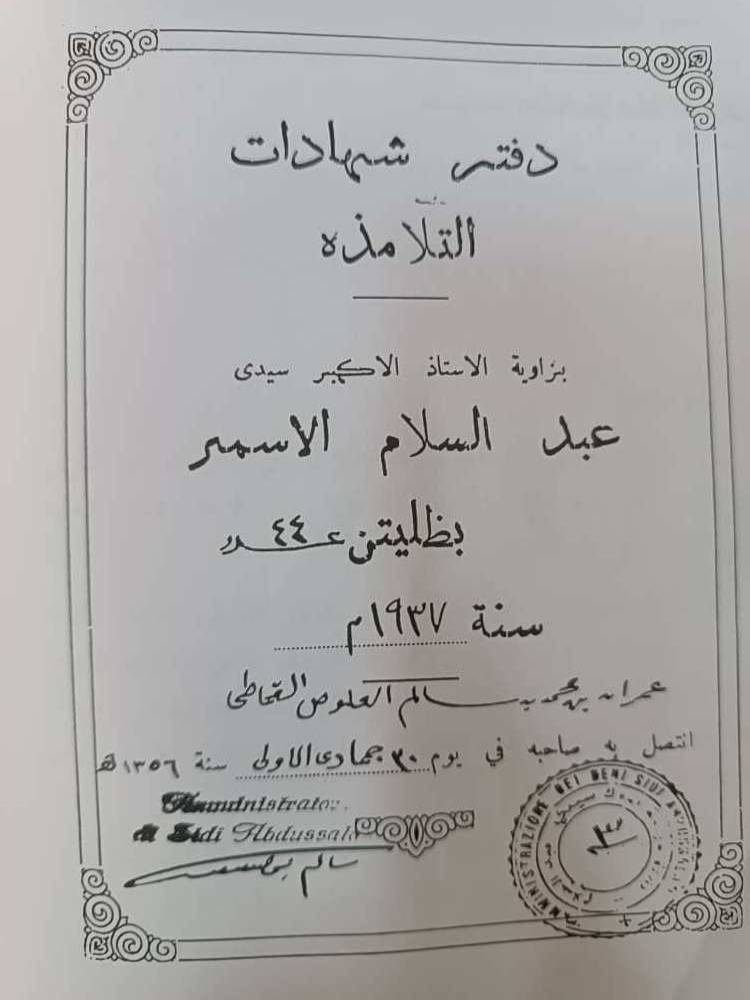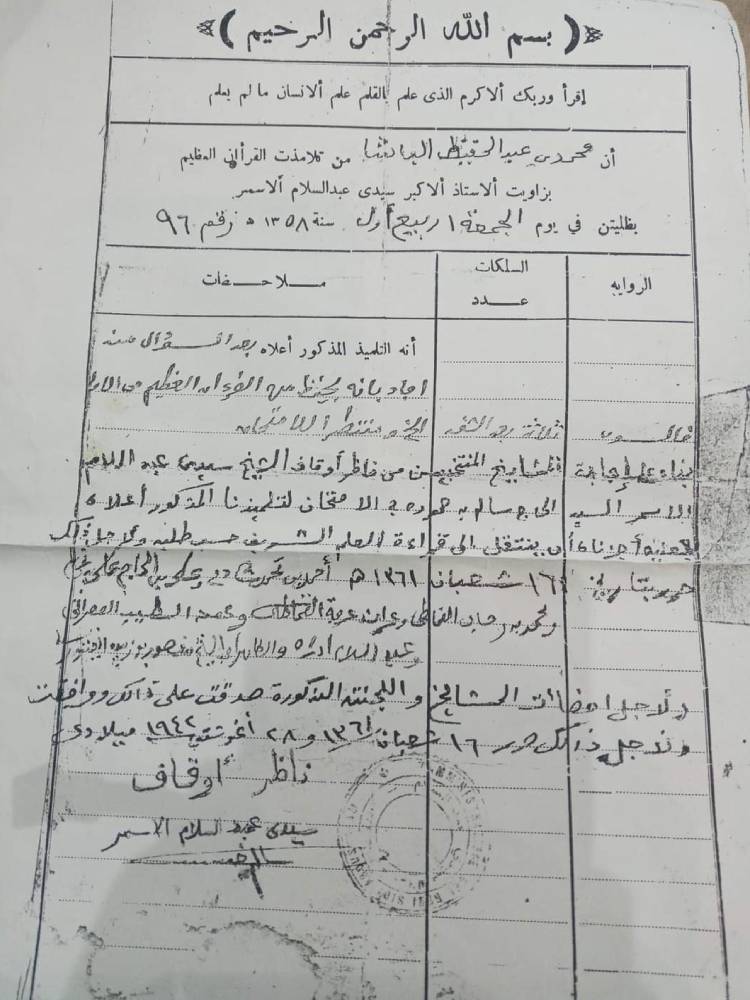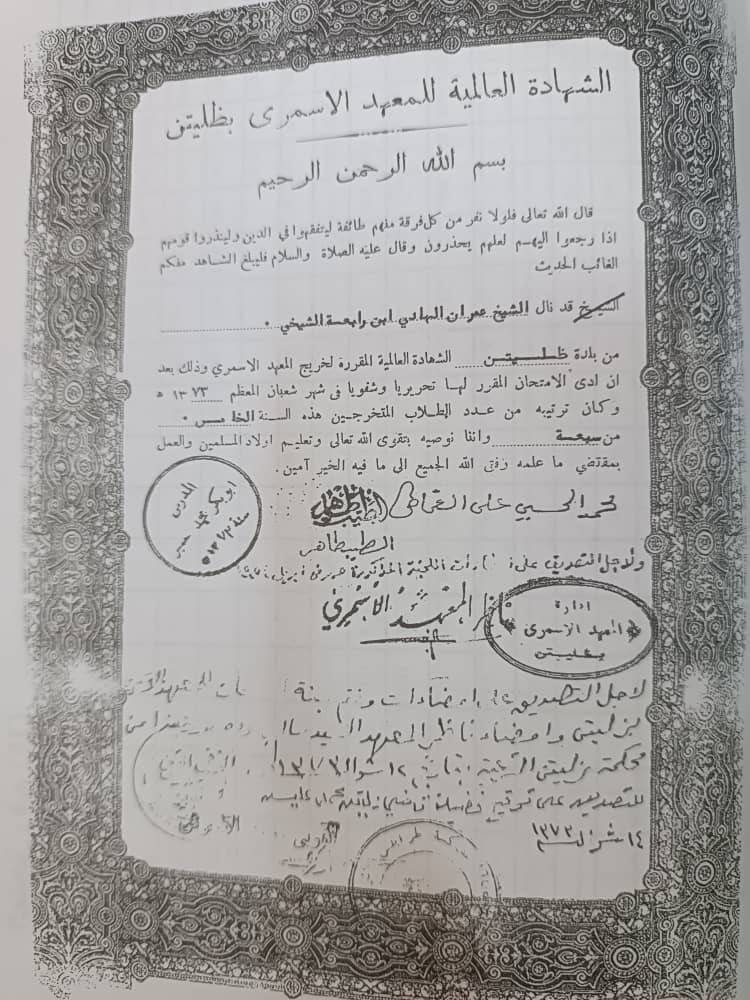
Home » The Historical Dimension and Phases of Development of AIU
The Historical Dimension and Phases of Development of AIU
Praise be to God, Lord of the worlds, and prayers and peace be upon the most honorable among prophets and messengers, Muhammad, the honorable Prophet, his family and companions, and those who are guided by his guidance until the Day of Judgment.
Alasmarya Islamic University (AIU) is simply an extension and cultural, civilizational and cognitive development of the Alasmari Quranic Center, which was founded by the virtuous educator Sheikh Abd al-Salam al-Asmar bin Salim al-Fitouri in 912 AH(1506 AD), who set academic and educational goals to address the prevailing conditions of the country at that time, such as the spread of illiteracy, and the social and political instability. Those goals included the memorization of the Holy Qur’an and the teaching of Sharia and linguistic sciences such as creed, Fiqh, Hadith, Interpretation, and Arabic language sciences to Muslim children, through organizing the scientific sessions for the seekers of knowledge.
Alasmari began as an endowment institution when its founder, Sheikh Abd al-Salam, endowed some of his property to be an endowment for it, so that the benefactors after him would continue to follow his footsteps by endowing for it, because of the scientific, cultural and social impact they felt in their surroundings, so that over time its endowment resources became a helping factor in its urban and scientific development.
The beginning of the twentieth century witnessed a kind of urban development at Alasmarya, which included its facilities, where an expansion took place in its house of prayer, and many rooms were added for the residence of students and other service facilities, thus becoming a large complex that accommodated the increasing number of sheikhs, students and guests who used to visit it frequently. Also, an academic development took place, the basis of which was the arrival of a group of scholars to teach there, after they had learned mainly in Alasmari Institute or in other academic institutes existing in Libya and they completed their academic carriers at Al-Azhar Mosque in Egypt, or Al-Zaytouna Mosque in Tunisia, so they had a great role in raising the level of education in this institution and its development and placing it in the ranks of the major institutes in neighboring countries. It has formed a modern educational system similar to that in Al-Azhar Mosque, so that there are academic stages, curricula, academic certificates, and qualified teachers. Accordingly, Al-Asmari Religious Institute arose from the form of Alasmari Quranic Center as an academic school that teaches Sharia and linguistic sciences, and issues academic certificates for its students in the modern style.
Sheikh Abd al-Salam al-Asmar Qur’anic Center in the city of Zliten during the Ottoman Era
(Source: Alasmari Institute Library)
Sheikh Abd al-Salam al-Asmar Qur’anic Center during the Italian occupation
(Source: Alasmari Institute Library )
Al- Asmari Religious Institute has been developed in several phases in successive periods of time, in which there has been a development in terms of academic stages, academic curricula, teaching methods, licenses and academic certificates granted to students as follows:
The First Phase:
It was between 1935-1952 AD. The Free Method of teaching was adopted, meaning that the student has the right to choose the book he wants learn, and the Sheikh who will his supervisor, without being restricted to a specific time . As for the curricula, they were all related to Sharia and linguistic sciences, such as Fiqh and its origins, Obligations, Monotheism, Hadith, Interpretation, Intonation, logic, Grammar, Morphology, and Rhetoric.
After the student has finished learning these books guided by his Sheikhs, he is given a written certificate in a special booklet known as the “Students’ Certificate Booklet”, so that each sheikh in this booklet approves the materials that the student learned under his supervision. Later, the International Certificate was introduced in 1947 AD, which is granted to the student after passing an oral exam conducted by a scientific committee that includes a group of sheikhs from the same institute along with external members.
Students’ Certificate Booklet granted to one of the students
issued by the head of the endowments at Alasmarian Institute on 30 Jumada Al-Awla 1356 AH/ 1937 AD
((Source: Alasmari Institute Library
A certificate granted to one of the students of Alasmarian Institute for proficiency in memorizing the Holy Qur’an and allowing him it to read the noble science
“Issued by the head of head of the endowments at Alasmarian Institute – Zliten on Shaaban 16, 1361 A.H/August 28, 1942 A.D.i4 ”
(Source: Alasmari Institute Library)
The Second Phase:
It lasted from 1952 to 1956 A.D. It witnessed the establishment of the Department of Education when the educational system was divided into three academic stages: the primary stage, which lasts for three years, during which the student studies simplified books of Sharia and linguistic sciences, and is examined at the end of each academic year. Having successfully passed the three academic years, the student obtains a Primary School Certificate. Then, he moves to the Qualified Certificate stage, which lasts for four years, in which the student studies Islamic and linguistic sciences extensively. By passing this stage, the student is awarded the Qualified Certificate that enables him to give lessons to beginner students. After that, the student moves to the International Certificate stage, which also lasts for four years, during which the student studies the advanced curricula of Sharia and linguistic sciences, and with his success in this stage, he is awarded the International Certificate, which allows him to teach at Al-Asmari Institute itself and/or other equivalent local institutes. Among the most prominent Sharia and linguistic sciences that were learned by the students in these stages: the science of monotheism, Fiqh, Grammar, Morphology, Rhetoric, Poetic rhythm, Logic, Science of Hadith, Interpretation of the Holy Qur’an, Inheritance, Intonation, and Astronomy.
The Primary Certificate of the ALasmari Institute granted to one of the students after passing the primary stage at the institute in the city of Zliten “issued by the head of the institute on Shaaban 15th, 1373 AH / 1954 AD”
(Source: Alasmari Institute Library)
The International Certificate of the Alasmari Institute granted to a graduate of the Institute in Zliten Issued by the Institute with the signature and seal of the director of the Asmari Institute and ratified by the Zliten Sharia Court on Shawwal 12th, 1373 AH/ 1954 AD
(Source: Alasmari Institute Library)
The Third Phase
It was between 1956 and 1957 AD where the academic stages consisted of: the primary stage, which lasts four years, the secondary stage, which lasts five years, and the international stage, which lasts four years. The academic program continued in this manner for one year, until Al-Asmari Religious Institute was joined to Al-Sayyid Muammad bin Ali Al-Senussi Institute in 1957 AD, and thus the academic stages and the academic curriculum changed announcing the start of the fourth period of the educational development in Alasmarya.
The Fourth Phase
It took place between 1957&1961 AD, and was characterized by a change in the academic stages and curricula according to what was in effect in the Institute of Sayyid Muhammad bin Ali al-Senussi, which were adopted from Al-Azhar academic system. The academic stages were divided into two stages. The primary stage, which lasts for four years, and the student joins it after memorizing the Holy Qur’an in the Qur’anic Centers. Having passed the exam that is held every one academic year, the student obtains the Primary Certificate that qualifies him to move to the Secondary Stage which lasts for five years. By passing this stage, the student obtains a Secondary School Completion Certificate that qualifies him to study in one of the similar pattern colleges of Sharia sciences and linguistic Sciences.
The Fifth Phase
It took place between 1962 &1986 AD. In 1962, Sayyid Muhammad bin Ali Al-Senussi Religious Institute was reformed and developed to become an Islamic University. There was a development in the academic stages and curricula so that the academic stages were divided into three stages: primary, preparatory and secondary stage, with a period of three years for each. By the end of this phase, another three academic years were added to the primary stage, which became represented in Quranic Schools. Curricula have also been modified to include applied sciences and social sciences along with Sharia and linguistic sciences. By passing the three stages and obtaining the High School Diploma, the student is qualified to study at the Faculties of Sharia, the Faculties of Fundamentals of Religion, and the Faculties of Arabic Language in Libyan universities, or other universities in the Arab and Islamic world. He is also qualified to work in state organizations, and allowed to work as an imam, preacher, and memorizer of the Holy Qur’an. in the Quranic schools.
The academic program at the institute continued in this way until 1986 when a decision was issued by the Education Secretariat to abolish religious education in Libya. However, it continued in the institute as informal academic sessions till 1995, when the Public Religious Education System was restored under the name of “Almanarat al-Sharia” (Sharia Secondary Schools) so that “Manarat alasmari” was among them
The Birth of AIU
In the vicinity of Alasmari Religious Institute in the city of Zliten, and from its womb was the birth of Alasmarya Islamic University (AIU). There is no doubt that the extension of the historical legacy of such educational institution for more than five centuries is an important element in its march. It is not only a catalyst for the process of transformation and development, but also accelerates the pace towards achieving the desired goal of establishing the university. As we find it clear in the establishment of the university by Resolution No. (257/ 1415 AH – 1996 AD) issued by the Council of Ministers (formerly the General People’s Committee) to establish Alasmarya University for Islamic Sciences. The text of the resolution included: (An academic institution called Alasmarya University for Islamic Sciences shall be established in accordance with the provisions of this resolution. It shall have a legal personality and independent financial liability. It shall be affiliated with the Ministry of Education, formerly “the General People’s Committee for Education and Scientific Research”, concerned with the religious education and the revival of Islamic heritage within the framework of higher education. It also supervises religious education in religious institutes and high schools of Sharia sciences, with the following academic departments: the Department of Sharia and Law, the Department of Fundamentals of Religion, and the Department of Arabic Language and Islamic Studies).
On January 27th, 2004, the Assistant Secretary for Services Affairs issued the resolution No. (269) regarding the upgrade of the three scientific departments at Alasmarya University for Islamic Sciences into faculties with adding a new faculty, the Faculty of Call, Imamate and Public Speech.
In 2007, the Faculty of Sharia Sciences Msallatah, which was affiliated with the University of Al-Marqab, was added to Alasmarya University, and two faculties of Islamic Studies were established, one in the city of Sebha and the other in the city of Al-Bayda, which was separated from the university later in 2012 to be the nucleus of the University of Sayyid Muhammad bin Ali Al-Senussi which had been revived recently.
The Current Status
The amendment of the name of Alasmarya University for Islamic Sciences came in accordance with Cabinet Resolution No. (444/ 2013 AD) issued on Ramadan 29, 1434 AH / 7/8/2013 AD) “Reporting Some Provisions Concerning Alasmarya University for Islamic Sciences,” which included “Modifying the name of Alasmarya University for Islamic Sciences to become (Alasmarya Islamic University (AIU)) and transferring the affiliation of the faculties existing in the city of Zliten and was affiliated with Al-Marqab University to Alasmarya Islamic University (AIU), namely: the Faculty of Economics and Political Science, whose name was later changed to be “Faculty of Economics and Commerce”, Faculty Dentistry, Faculty of Marine Resources, Faculty of Education, Faculty of Arts, and Faculty of Sciences.
The resolution also stipulates that it is permissible to create new faculties affiliated with the university when needed. New faculties have been accordingly created namely: Faculty of Humanities for Females, Faculty of Engineering, Faculty of Information Technology, Faculty of Medicine, Faculty of Pharmacy, Faculty of Public Health, and Faculty of Nursing, whose name was later changed to be “Faculty of Health Sciences”, while the faculty of Fundamentals of Religion, and the faculty Da’wah, Imamate and Public Speech were combined into one faculty under the name of “Faculty of Da’wah and Fundamentals of Religion”.
This resolution has led to a remarkable development in the university’s vision, mission, objectives, activities, and educational and research programs. It is no longer a university specialized strictly in Islamic sciences, but included other humanities and applied sciences and knowledge, in a way that meets the need and development of the society.
Faculties affiliated to Alasmarya Islamic University were frequently established in a number of regions of Libya, especially those specialized in religious sciences, either through innovating or upgrading some external campuses into faculties. In 2015, for instance, the campus in Msallata, affiliated to the Faculty of Economics at Al-Marqab University, were upgraded to be a Faculty affiliated with Alasmarya Islamic University under the name of “Faculty of Commerce and Islamic Economics”, whose name was later amended to be “Faculty of Economics Msallatah”.
In 2018, a new faculty was established in the city of Ubari, named “Faculty of Sharia and Law, Ubari”.
In 2022, the campus of Zawiyat al-Mahjoub, Misrata, was upgraded to be a faculty named: “Faculty of Sharia Sciences – Zawiyat al-Mahjoub”, and the campus in Ghat city was also upgraded to be a faculty named: “Faculty of Sharia and Law Ghat”. Likewise, a new faculty of Sharia sciences was established in the city of Benghazi.
There are yet many official and public demands from all around the country that ask for establishing more faculties specialized in Islamic sciences affiliated with Alasmarya Islamic University (AIU).

Contact Us
Email
[email protected]
Phone Number
(++218)-51 462 0044
(++218)-51 462 6679
(++218)-51 462 3231
FAQs
Technical support
Complaints and suggestions
Number of Visitors

A distinguished Islamic university in the field of higher education and scientific research in Islamic, humanitarian and applied sciences that effectively contributes to the promotion of social peace and the creation of sustainable national development.
Contact Us
Email
[email protected]
Phone Number
(++218)-51 462 0044
(++218)-51 462 6679
(++218)-51 462 3231







